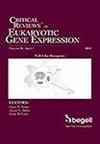Pan-cancer analysis of the LOX family reveals that LOX affects tumor prognosis by affecting immune infiltration
IF 1.5
4区 医学
Q4 BIOTECHNOLOGY & APPLIED MICROBIOLOGY
Critical Reviews in Eukaryotic Gene Expression
Pub Date : 2023-01-01
DOI:10.1615/critreveukaryotgeneexpr.2023049049
引用次数: 0
Abstract
Background: The LOX (lysyl oxidase) gene family encodes for a group of copper-dependent enzymes that play a crucial role in the cross-linking of collagen and elastin fibers in the extracellular matrix (ECM). Dysregulation of LOX gene expression has been implicated in various pathological conditions, including cancer. Objectives: The goal of this article is to conduct a comprehensive analysis of the LOX family's role in pan-cancer multiplexes. Material and methods: We utilized pan-cancer multi-omics sequencing data from TCGA to investigate the relationship between LOX family genes and tumors at four different levels: mutation, copy number variation, methylation, and gene expression. In addition, we also examined the relationship between LOX family genes and tumors at the cell line level using tumor cell line sequencing data from CCLE. Results: Our findings revealed that LOXL2 had the highest mutation frequency in tumors, while all four LOX family genes experienced some degree of copy number variation in diverse tumors. We observed that LOX, LOXL1-3 were predominantly highly expressed in tumors including LUAD. The expression trends of LOX and LOXL1-3 were consistent across tumor cell lines, but differed somewhat from LOXL4. Utilizing 25 LOX family-related genes, we constructed a LOX family prognostic model that performed well in predicting the prognosis of lung cancer. Conclusions: Through pan-cancer analysis, we gain further knowledge of the role of LOX family genes in different tumors, offering a novel pathway for future research into the relationship between LOX family genes and tumors.LOX家族的泛癌分析表明,LOX通过影响免疫浸润影响肿瘤预后
背景:赖氨酸氧化酶(LOX)基因家族编码一组铜依赖性酶,这些酶在细胞外基质(ECM)中胶原和弹性蛋白纤维的交联中起关键作用。LOX基因表达的失调与包括癌症在内的各种病理状况有关。目的:本文的目的是全面分析LOX家族在泛癌症多重因素中的作用。材料和方法:利用TCGA的泛肿瘤多组学测序数据,从突变、拷贝数变异、甲基化和基因表达四个不同水平研究LOX家族基因与肿瘤的关系。此外,我们还利用CCLE的肿瘤细胞系测序数据,在细胞系水平上研究了LOX家族基因与肿瘤之间的关系。结果:我们的研究结果显示LOXL2在肿瘤中的突变频率最高,而LOX家族的四个基因在不同的肿瘤中都有一定程度的拷贝数变异。我们观察到LOX、LOXL1-3在包括LUAD在内的肿瘤中主要高表达。LOX和LOXL1-3在不同肿瘤细胞系的表达趋势一致,但与LOXL4有一定差异。利用25个LOX家族相关基因,我们构建了LOX家族预后模型,该模型在预测肺癌预后方面表现良好。结论:通过泛癌分析,我们进一步了解了LOX家族基因在不同肿瘤中的作用,为进一步研究LOX家族基因与肿瘤的关系提供了新的途径。
本文章由计算机程序翻译,如有差异,请以英文原文为准。
求助全文
约1分钟内获得全文
求助全文
来源期刊

Critical Reviews in Eukaryotic Gene Expression
生物-生物工程与应用微生物
CiteScore
2.70
自引率
0.00%
发文量
67
审稿时长
1 months
期刊介绍:
Critical ReviewsTM in Eukaryotic Gene Expression presents timely concepts and experimental approaches that are contributing to rapid advances in our mechanistic understanding of gene regulation, organization, and structure within the contexts of biological control and the diagnosis/treatment of disease. The journal provides in-depth critical reviews, on well-defined topics of immediate interest, written by recognized specialists in the field. Extensive literature citations provide a comprehensive information resource.
Reviews are developed from an historical perspective and suggest directions that can be anticipated. Strengths as well as limitations of methodologies and experimental strategies are considered.
 求助内容:
求助内容: 应助结果提醒方式:
应助结果提醒方式:


